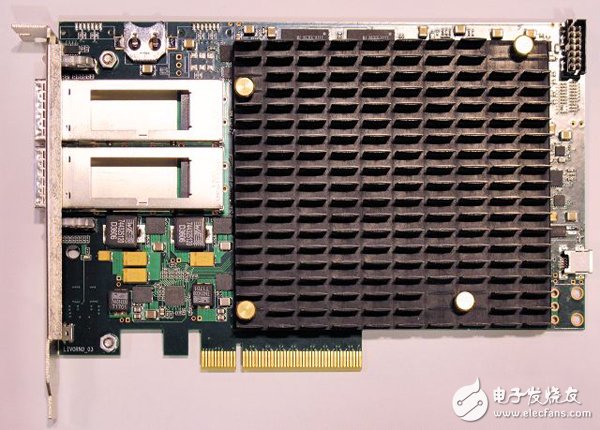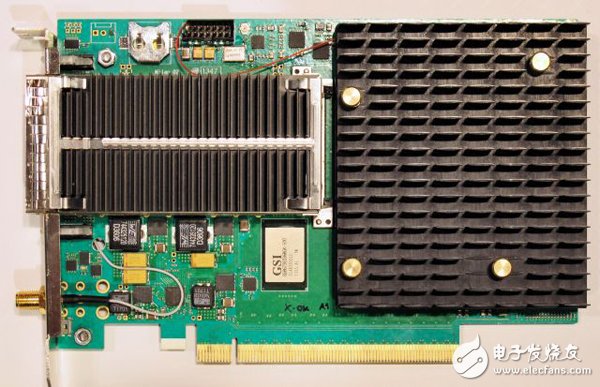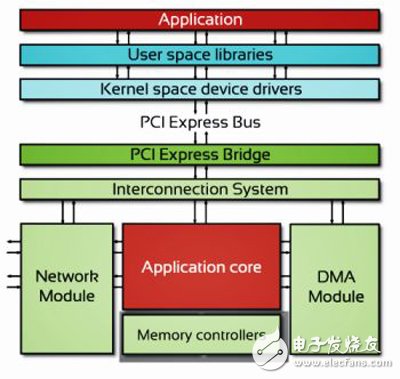INVEA-TECH has produced FPGA-based hardware accelerated Ethernet interface cards (HANICs). This week, the company demonstrated two high-speed Ethernet adapter cards, the COMBO 80G and the recently released COMBO 100G, at the Ethernet Technology Summit in Santa Clara, Calif., which focused on board-level FPGAs and optical Ethernet modules. Both cards use the same underlying hardware architecture. First, the high-speed Ethernet data stream enters the adapter card through the appropriate optical port, and then processed in the board-level FPGA, mainly to achieve various network monitoring and acceleration tasks. Finally, the processed data stream is sent to the host system via a PCIe Gen3 interface or sent back over an optical Ethernet connection.
The differences between the two cards are described in detail below:
The INVEA-TECH COMBO 80G HANIC can connect two 40Gbps QSFP+ fiber (or copper) Ethernet transceiver modules. A board-level Virtex-7 690T FPGA is used to receive Ethernet traffic, which communicates with two QFSP+ modules via four GTH 13.1Gbps SerDes operating at 10Gbps. The programmable hardware logic inside the FPGA handles the packets in the Ethernet data stream and communicates with the onboard PCIe Gen3 x8 host interface. This is a picture of the INVEA-TECH COMBO 80G HANIC:

INVEA-TECH COMBO 80G hardware-accelerated NIC (HANIC)
Similarly, the INVEA-TECH COMBO 100G HANIC is connected to a 100Gbps CFP2 fiber optic Ethernet transceiver module, and the board-level Virtex-7 H580T 3D FPGA is used to receive Ethernet data streams through four GTZ 28.05 operating at 25Gbps. Gbps SerDes to communicate with two CFP2 modules. Higher Ethernet transfer rates require a PCIe Gen3 x16 host interface to handle additional traffic bandwidth. Below is a picture of the INVEA-TECH COMBO 100G HANIC board. By comparing the PCIe connectors on the top and bottom of the figure, you can See the difference.

INVEA-TECH COMBO 100G hardware-accelerated NIC (HANIC)
Because they are all designed based on FPGAs, the two INVEA-TECH HANIC boards offer some network processing options, including packet sampling, traffic monitoring, packet filtering, traffic analysis, and traffic distribution across multiple processor cores. .
The company's NetCOPE FPGA architecture dictates the rapid development of network applications using these FPGA-based HANIC accelerator boards. This architecture provides a hardware-independent abstraction layer that quickly handles repetitive development tasks such as storage control, network connectivity, host communication, and provides a configurable interface to a custom application kernel. Products developed using the NetCOPE architecture cover different application areas such as VoIP analysis, information encryption, HPC (high performance computing), security, bioinformatics, and high-speed electronic transactions.
This is a generic block diagram of the NetCOPE architecture:

INVEA-TECH NetCOPE Architecture
(Note: Xilinx today announced that the Kintex UltraScale FPGA is the first 20nm device to implement the PCI Express specification and is listed on the PCI-SIG integrator list. The UltraScale family of devices supports PCIe Gen3 through a 16Gbps GTH SerDes transceiver, each device 2 to 6 PCIe modules integrated in the system)
Usb-C To Usb-C Cables,Pd Fast Charging Usb Cable,Usb C To Type C Braided Cable,Usb Cable For Tablet
Dongguan Pinji Electronic Technology Limited , https://www.iquaxusb4cable.com